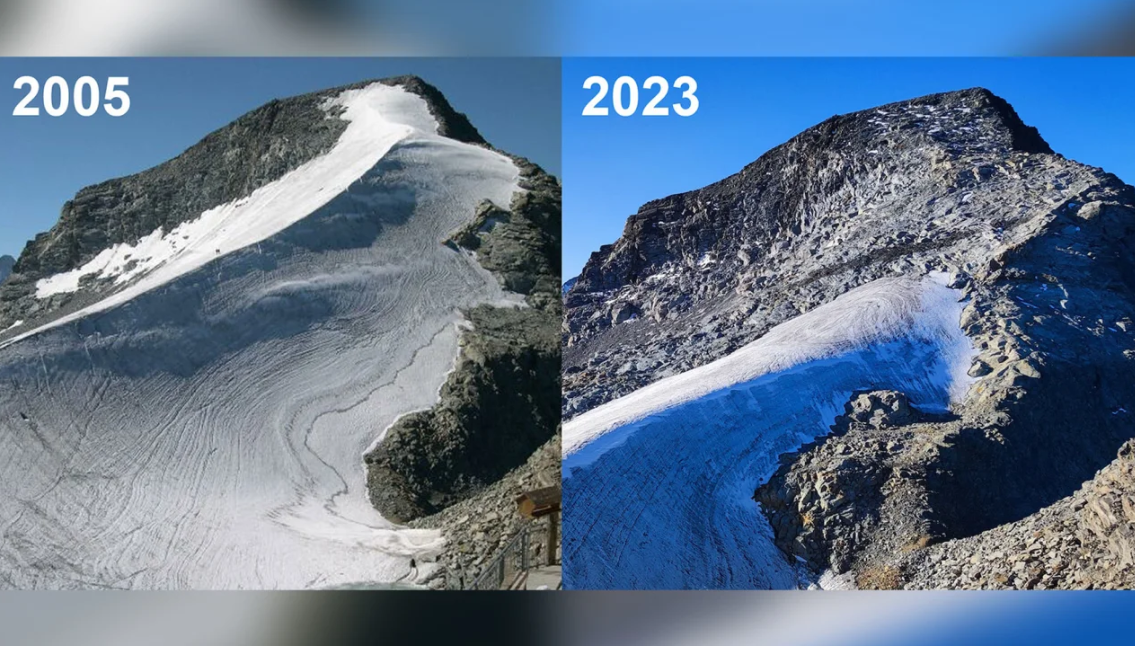
©Matthias Huss/GLAMOS
Pre-reading questions:
I will read each question. Then, please answer them.
- What do you already know or think about ‘glaciers’?
- Have you already experienced the effects of climate change? In what way?
Vocabulary:
I will read the words, meanings, and sample sentences. Then, repeat after me.
- rapid /RAP-id/
- link /lingk/
- vanish /VAN-ish/
- shrink /shringk/
- vital /VAHYT-l/
[adjective] – fast or sudden
She made a rapid decision to accept the job offer without much deliberation.
[verb] – to make a connection between two or more people, things, or ideas
The professor linked various concepts to illustrate the broader theory.
[verb] – to disappear or stop being present or existing, especially in a sudden, surprising way
As the fog lifted, the distant mountains seemed to vanish into thin air.
[verb] – to become smaller, or to make something smaller
After washing the sweater in hot water, it shrank and no longer fit properly.
[adjective] – necessary for the success or continued existence of something; extremely important
Proper nutrition is vital for maintaining good health.
Article reading:
Please read the whole article. Then, I will check your pronunciation and intonation.
Switzerland’s glaciers are undergoing a remarkable transformation, described by experts as “mind-blowing.” In just two years, 10% of their ice volume has disappeared due to a combination of reduced snowfall and rising temperatures. Data from the Swiss Commission for Cryosphere Observation reveals a 4% loss in glacier volume in 2023, following a record-breaking 6% loss in 2022. To put this in perspective, the ice loss over these two years matches that of the entire three decades between 1960 and 1990.
Matthias Huss, head of Swiss Glacier Monitoring, is greatly alarmed. He stresses that the recent rapid glacier loss is directly linked to climate change. The results are serious: glaciers are collapsing, and smaller ones are vanishing. Even in high-altitude areas, where this was less common, there’s now ice loss. These losses across the country coincide with a winter of very little snow. A hot summer caused early snowmelt. This fast glacier retreat brings instability and sad discoveries. While more water helps temporarily, as glaciers shrink, their vital role in supplying water lessens, worsening shortages during heatwaves. The future looks grim, urging immediate action. Studies suggest that even with ambitious climate goals, up to half of the world’s glaciers could be gone by the century’s end.
Matthias Huss, head of Swiss Glacier Monitoring, is greatly alarmed. He stresses that the recent rapid glacier loss is directly linked to climate change. The results are serious: glaciers are collapsing, and smaller ones are vanishing. Even in high-altitude areas, where this was less common, there’s now ice loss. These losses across the country coincide with a winter of very little snow. A hot summer caused early snowmelt. This fast glacier retreat brings instability and sad discoveries. While more water helps temporarily, as glaciers shrink, their vital role in supplying water lessens, worsening shortages during heatwaves. The future looks grim, urging immediate action. Studies suggest that even with ambitious climate goals, up to half of the world’s glaciers could be gone by the century’s end.
Comprehension questions
I will read each question. Then, please answer them based on the article.
- How much of Switzerland’s glacier ice volume has disappeared in just two years?
- What are the main factors contributing to the loss of glacier ice in Switzerland?
- What are some of the consequences of the rapid glacier retreat in Switzerland?
- Why is the recent glacier loss in Switzerland described as “mind-blowing” by experts?
- How has the recent lack of snowfall and hot summer affected the glaciers?
Discussion questions
I will read each question. Then, please answer them.
- Have you ever been to a place with a lot of ice or glaciers? If so, how was it? If not, would you want to go in the future? Why or why not?
- Have you ever talked about or done things related to climate change and how it affects nature, like glaciers? Did these talks or actions change how you see the importance of dealing with climate issues? If not, would you think about joining such discussions or activities in the future? Why or why not?
- Do you think the fast melting of ice in Switzerland’s glaciers is something we should worry about right away because of climate change?
- With Switzerland’s glaciers melting quickly, how could this make other countries and big groups worldwide think more seriously about their plans to deal with climate change? What new rules or ideas might come out of this rush?
- Because glaciers are disappearing, it could really affect water, farming, and tourism in many places. What do you think are the most important plans for areas that will be affected to adjust to these changes and keep things going well for the long term?